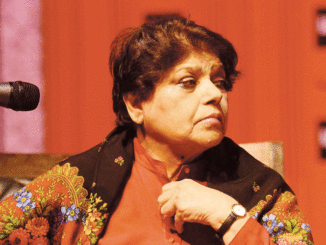
A Review on Urdu Quarterly Istifsaar
by, Meraj Rana
The purpose of publishing magazines in any language is not only to acquaint the readers with the excellent works of literature created in that language, but also to make every possible effort to discuss the works of art published in it.
It is obvious that the nature and quality of any magazine is determined by the scholarly temperament and quality of its editor. Probably this is the reason why in every age, great magazines of every language have always proved to be a boon of brilliant minds.
An example is The Criterion in English. It was a British literary magazine published by a prominent English poet, playwright and critic T.S. Eliot from 1922 to 1939. It was published regularly every month under the editorship of Eliot.
Regarding the quality of this magazine, George Orwell wrote in a letter to his friend in 1935 that the excellent articles I had read in this magazine had not been read in any other magazine. The first issue of this magazine was six hundred, and among the creative contributors of its first publication were Virginia Woolf, W.B. Yeats, E.M. Forster and Ezra Pound. One of the hallmarks of the magazine was the fact that it produced for the first time in English the works of prominent French writers such as Marcel Proust and Paul Valery.
Prominent English critics F.R. Leavis and K.C. Knights edited the magazine Scrutiny, which was also of great importance. Similarly, the Russian-language Fakel and the French language magazine Tel Quel are well known for their intellectual discussions.
Like English, the history of Urdu literary journalism is enviable. But after the closure of Shabkhoon, the emptiness that was created in Urdu literary journalism has been filled to a large extent by the publication of Istifsaar. This quarterly magazine is published from Jaipur under the editorship of Sheen.Kaaf. Nizam and Adil Raza Mansoori, which in terms of creative and critical literature seems to be the most distinguished and unique among all other magazines published from India.
The latest issue of Istifsaar is important in many ways. Nasir Abbas Nayyar’s article on Zahid Dar’s poetry highlights aspects of his poetry. His article may seem formal, but in fact it is not formal, completely critical in nature. One of the main features of Nasir Abbas Nayyar’s criticism is that he studies any work of art in all its intellectual and artistic contexts. Therefore, creative texts (during study) seem to dominate like time.
This attitude of Nasir is very noticeable while writing on Zahid Dar’s poetry. One of the virtues of Nasir Abbas’s article is that he has also paid attention to the issues that make it possible to form a literary culture. However, it can be said that this article of Nasir Abbas Nayyar represents some elements of cultural criticism.
Similarly, Asif Farrukhi’s long interview with Shamim Hanafi is not just a formal conversation but a contentious dialogue between two literary scholars. These dialogues lead to confessions and disagreements with many of Shamim Hanafi’s views on literature. In this interview, many worrying points about old and new Urdu fiction have been discussed which other people do not dare to express. Shamim Hanafi is one of the few Urdu critics whose scope of study is very wide.
Be it poetry or fiction, he has written criticism on every genre. Excellent examples of his rational style and interdisciplinary approach, like his criticism, are also present in this interview. One of the distinguishing features of this interview is that the scholarly personality of Asif Farrukhi also seems to be completely brilliant. The nature of the questions indicates the breadth of the questioner’s study.
The same issue of Istifsaar also includes an article by Khalid Jawed, The First Postmodern Novel in Urdu in which he has read Ashar Najmi’s novel with reference to Milan Kundera which can be agreed on one level and disagreed on another.
Kundera is undoubtedly a great novelist, but his views on fictional theory are themselves a barrier in understanding his novel. Khalid Jawed writes at the beginning of this article that the skill of absorbing things becomes very important when using the technique of the novel. He further quotes Kundera as saying that the novel should not be like a building that is not visible.
It has never been accepted in the literature of any language that something should be accepted just because it has been said by an important person. If we (like Khalid Jawed) believe in this statement of Kundera, we can ask the question here with respect about the novels The Idiot (Dostoevsky-1869) and Aag ka Dariya (Qurratul Ain Hayder-1959) that the events in these two novels are so diverse that some parts of their plots (buildings) are not visible to us. There are so many events in the lives of Prince Myshkin and Abul Mansoor Kamaluddin that the reader cannot remember them.
The second point of this article is that he has proved Ashar Najmi’s novel to be a postmodern novel based on the subject. All I have to say in this regard is that no clear definition of postmodernism has been defined by Ihab Hassan to the present day.
In fiction, the discussion of the subject is usually of a key nature. As a result, other debates are always put on hold. The thing about fiction is that it does not describe a subject but is an artistic expression of the author’s views on the subject. Undoubtedly, Khalid Jawed is the only fiction writer of our time who has no contemporary fiction writer close to his artistic status. He has more skill in living fiction than writing fiction.
Khalid Jawed’s article is good, but it could have been even better if he had raised a few questions about the subject and form that would bring the dialectical debate to its logical conclusion.
Adil Raza Mansoori’s article Miraji and Post Recitation in the latest issue of Istifsaar is a new addition to the interpretation of Miraji’s poetry. The poetry section is better overall but in fiction Syed Mohammad Ashraf’s story represents his specific style.




